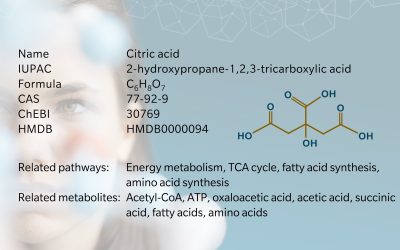
biocrates blog
Applications of metabolomics
Citric acid – Key metabolite in energy production, bone health, and disease therapy
A key metabolite in cellular energy production and various physiological processes such as fatty acid metabolism, amino acid synthesis, calcium signaling, anticoagulation and the regulation of pH balance.
Precision nutrition – Unlocking health through metabolomics
Discover how metabolomics drives precision nutrition, offering personalized insights into the connection between diet, well-being, and healthier lifestyles.
Oxaloacetic acid (OAA) – Key metabolite in metabolism, disease, and therapeutic innovation
A key metabolite in the citric acid cycle, essential for energy production and metabolic processes
Introduction to metabolomics in action
This lunch and learn event, sponsored by biocrates life sciences and hosted by Dr. Candace Guerrero, Assistant Director of the Center for Metabolomics and Proteomics at UMN, will feature presentations on cutting-edge research in metabolomics.
Investigating the stool and plasma metabolome of people with HIV
This lunch and learn event, sponsored by biocrates life sciences and hosted by Dr. Candace Guerrero, Assistant Director of the Center for Metabolomics and Proteomics at UMN, will feature presentations on cutting-edge research in metabolomics.
Metabolomics of sepsis and critical illness
This lunch and learn event, sponsored by biocrates life sciences and hosted by Dr. Candace Guerrero, Assistant Director of the Center for Metabolomics and Proteomics at UMN, will feature presentations on cutting-edge research in metabolomics.
Fast-tracking interpretation and sharing of lipidomic data with standardized methods
This talk will be especially aimed at scientists who are unsure how to analyze lipidomics and are looking for guidance.
Common pitfalls in clinical metabolomics: A guide from sample collection to data analysis
In this talk, I will highlight common pitfalls in the clinical metabolomics workflow and introduce useful tools to address these issues. This presentation is aimed at scientists involved in clinical projects who seek guidance on pre-analytical and dataset integration challenges.
Elucidating the impact of food-derived microbial metabolites on intestinal health
In my talk, I will present examples of applications of metabolomics in various sample matrices and how to use this powerful tool to study the effects of the microbiome on the host.
Metabolomics meets microbiome – Investigating host response with quantitative metabolomics
In my talk, I will present examples of applications of metabolomics in various sample matrices and how to use this powerful tool to study the effects of the microbiome on the host.










